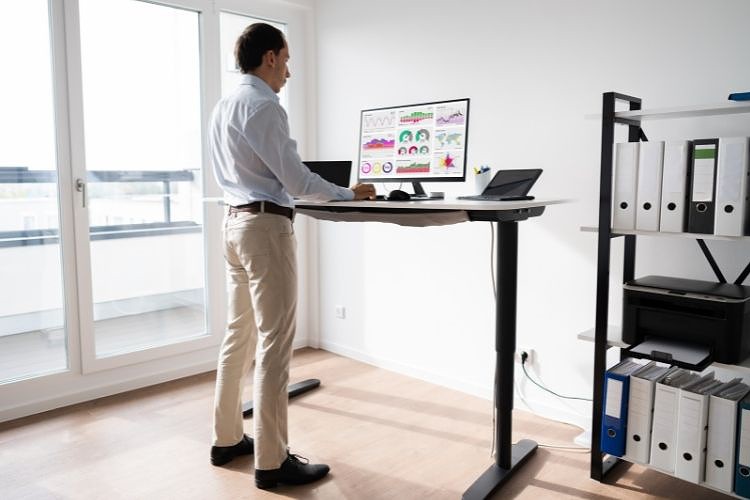Today, we are all aware of the impact that prolonged sitting has on our overall health. A sedentary life has been linked to various diseases and illnesses. Poor posture, obesity, cardiovascular diseases, back pain, and strained muscles are some of the many issues associated with extended sitting periods.
Of all these problems, poor posture is probably one of the most common health concerns seen today. It is also a significant reason people switch from a regular chair to alternatives like a standing desk.
A standing desk can be an excellent investment for your office space. If you are trying to include physical activity into your routine and overcome poor posture syndrome, a standing desk is the first and one of the best steps you can take to address your posture and back issues.
In this article, we explore how a standing desk can help with posture problems and how you can use it effectively to reap its maximum benefits.
Table of Contents
Do Standing Desks Improve Posture?
Yes. Compared to a traditional desk, a standing desk offers many health benefits including correcting your posture.

There is a high chance that you are reading this article from the comfort of your chair. There is also a good possibility that you have been mentally and physically affected by poor posture resulting from sitting for long hours. This has probably also led to several other health issues, some that you are aware of and some that are yet to make an appearance.
If you can relate to this, it is about time you are introduced to the wonders a standing desk offers.
When we sit for, let’s say, a couple of hours at a stretch, we contort our body in a position it is not generally used to. This leaves our muscles strained, back stiff, and compresses the spinal discs.
A standing desk affords you more opportunities to keep your back and spine aligned, thus helping improve your posture.
Benefits Of A Standing Desk For Posture
A standing desk provides your body with a much-needed break from staying seated almost throughout the day.

- You get ample space to stretch your body and loosen your muscles with a standing desk.
- It protects your muscles from stiffening and gives a break to the lower part of your body, which endures your total body’s weight when sitting.
- Studies have shown that people who switched to a standing desk observed a significant improvement in their posture and experienced reduced lower back pain.
- When you sit for too long in the same position, your hip flexors get shortened and tightened, your back starts hurting, and your posture gets negatively affected. When you stand, all the three natural curves of your spine, the one at the neck, the mid-back, and the lower back, are in perfect alignment.
- While standing, you are more mindful of your posture and flexibility in changing your position.
Apart from helping with your posture, standing at a desk is also known to lower your risk of developing many diseases and illnesses. When you spend more time on your legs, your heart becomes healthier. Your risk of gaining weight due to prolonged sedentary periods decreases, and so does your risk of obesity, type 2 diabetes, high blood pressure, and irregular cholesterol levels.
How Can I Improve My Posture At My Standing Desk?
To use your standing desk effectively and ensure that it assists you in improving your posture, there are certain factors you should take into consideration:

- Your body, which includes your head, neck, torso, and legs, should be in a straight, vertical line, and be in complete alignment.
- If you have to work on a monitor, make sure it is at least an arm’s distance away from you. There should be a minimum distance of 20 inches between the screen that is kept on the standing desk and your eyes to keep your posture in check.
- To avoid putting strain on your neck and shoulders, make sure you are in an upright position, use a headset to take calls, and prevent slouching under all circumstances.
- The height of your standing desk should be such that your wrists are completely straight and near your body when you are working on the keyboard.
- Make sure your shoulders are completely relaxed and try to pull your stomach in. Keep your back straight, your head at level, arms hung down naturally at your sides, and both your feet at least a shoulder’s length apart from each other.
How Long Should You Stand At A Standing Desk
It is important to alternate between standing and sitting when you spend almost half your day working at a desk. The more positions you switch, the more active your body stays. This allows you to successfully dodge possible health implications that come your way.

A standing desk offers you the best of both worlds. Most standing desks are height-adjustable, so you can use it while standing and pull the desk down so you can also use a chair for sitting and working.
For efficiency and optimal productivity, it is recommended to stand and work for an hour for every hour or two you spend sitting. Ideally, you should alternate your standing and sitting position after every 30 to 60 minutes to prevent your body from becoming too inert and stiff.
Is Standing At Your Desk Better Than Sitting?
It is crucial that you try to strike a balance between sitting and standing at work. Remaining stationary and inactive while staying in either position — standing or sitting — will undeniably lead to several health issues that you are likely to face down the line.

Compared to sitting, however, standing at your desk while working will always be considered a better option. It not only improves the circulation of blood in your body but also helps avoid putting any extra pressure on your back, neck, and shoulder muscles. Regular use of a standing desk also helps you improve your posture without any discomfort and pain.
Conclusion
A standing desk has been one of the most significant discoveries in recent years. It is known to help avoid all the scary episodes of neck pain, muscle fatigue, soreness, shoulder pain, back pain, digestive issues, and circulatory system problems resulting from poor posture.
A small investment in a standing desk today can save you from exorbitant costs to fix your health issues in the future. Hopefully, you have learned all that you wanted to know about standing desks to make an informed decision and help improve your bad posture.

My name is Vance, and I am the owner of To Ergonomics. Our mission is to improve your workflow by helping you create a supportive and welcoming environment. We hope that you’ll find what you’re looking for while you’re here.

